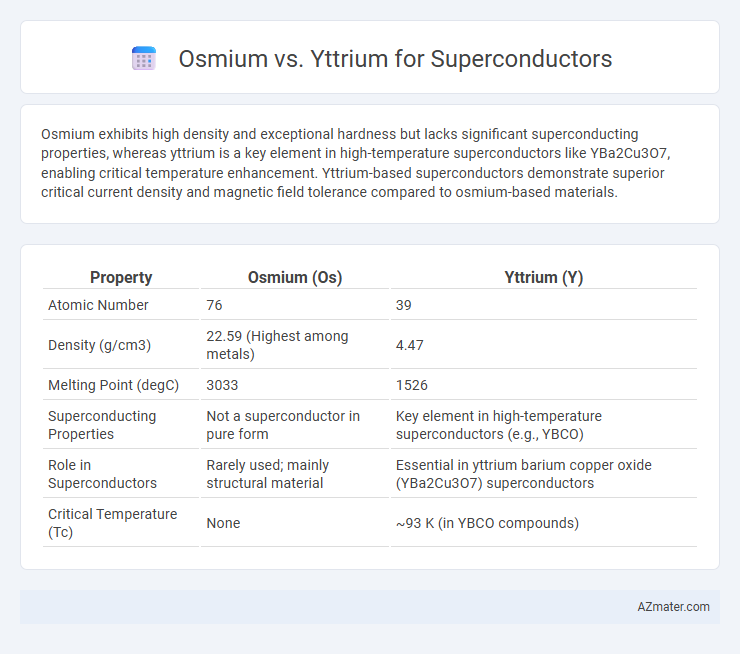Osmium exhibits high density and exceptional hardness but lacks significant superconducting properties, whereas yttrium is a key element in high-temperature superconductors like YBa2Cu3O7, enabling critical temperature enhancement. Yttrium-based superconductors demonstrate superior critical current density and magnetic field tolerance compared to osmium-based materials.
Table of Comparison
| Property | Osmium (Os) | Yttrium (Y) |
|---|---|---|
| Atomic Number | 76 | 39 |
| Density (g/cm3) | 22.59 (Highest among metals) | 4.47 |
| Melting Point (degC) | 3033 | 1526 |
| Superconducting Properties | Not a superconductor in pure form | Key element in high-temperature superconductors (e.g., YBCO) |
| Role in Superconductors | Rarely used; mainly structural material | Essential in yttrium barium copper oxide (YBa2Cu3O7) superconductors |
| Critical Temperature (Tc) | None | ~93 K (in YBCO compounds) |
Introduction to Superconductors
Superconductors are materials that exhibit zero electrical resistance and expel magnetic fields below a characteristic critical temperature, enhancing energy efficiency and magnetic applications. Osmium, a dense transition metal, and yttrium, a rare-earth element, have distinct electronic structures influencing their superconducting properties; yttrium is notably used in yttrium barium copper oxide (YBCO), a high-temperature superconductor with critical temperatures exceeding 90 K. The comparison between osmium and yttrium showcases the importance of elemental composition and crystal structure in achieving superconductivity suitable for technological advancements.
Overview of Osmium and Yttrium
Osmium is a dense transition metal known for its exceptional hardness and high melting point, often utilized in applications requiring durable materials, whereas yttrium is a rare earth element valued for its role in stabilizing the crystal structure of high-temperature superconductors. Osmium's electronic configuration and lattice structure make it less common in superconductor research compared to yttrium, which extensively contributes to yttrium barium copper oxide (YBCO), a well-studied high-temperature superconductor. Yttrium's ability to enhance superconducting critical temperature and current density distinguishes it as a critical element in superconductor development.
Atomic Structures and Properties
Osmium and yttrium exhibit distinct atomic structures influencing their superconducting properties, with osmium possessing a dense hexagonal close-packed lattice and yttrium featuring a hexagonal crystal system prone to superconductivity enhancement through alloying. Osmium's high electron density and strong spin-orbit coupling contribute to its limited superconductivity under extreme conditions, whereas yttrium's atomic arrangement allows for higher critical temperatures when combined with elements like barium and copper. These differences in atomic geometry and electronic configuration are critical for tailoring superconducting materials in advanced applications.
Electrical Conductivity Comparison
Osmium exhibits higher electrical conductivity compared to Yttrium due to its dense atomic structure and strong metallic bonding, making it a promising candidate for superconductor applications requiring efficient electron transport. Yttrium, while less conductive, plays a crucial role in high-temperature superconductors such as YBCO (Yttrium Barium Copper Oxide), where it contributes to structural stability and superconducting phase formation but does not dominate conductivity. The disparity in intrinsic conductivity between Osmium and Yttrium influences their respective superconductor performance, with Osmium favoring low-temperature, high-conductivity scenarios and Yttrium enabling complex oxide superconductors with higher critical temperatures.
Critical Temperature and Superconductivity
Osmium exhibits superconductivity at extremely low critical temperatures around 0.7 K, limiting its practical applications, while yttrium-based compounds, such as yttrium barium copper oxide (YBCO), demonstrate significantly higher critical temperatures exceeding 90 K, enabling more feasible superconducting technologies. YBCO's high critical temperature allows superconductivity under liquid nitrogen cooling, contrasting sharply with osmium's need for much lower temperatures. The superior superconducting properties of yttrium compounds position them as key materials in practical high-temperature superconductor applications, unlike osmium's low-temperature superconductivity.
Magnetic Properties: Osmium vs Yttrium
Osmium exhibits strong magnetic anisotropy due to its 5d electron configuration, contributing to robust spin-orbit coupling effects that influence its superconducting behavior. In contrast, yttrium is paramagnetic with a relatively weak magnetic moment, which minimally interferes with Cooper pair formation, enhancing its suitability as a superconductor host or dopant. The distinct magnetic properties of osmium and yttrium significantly affect their electron pairing mechanisms and critical magnetic fields in superconducting applications.
Material Abundance and Availability
Osmium, one of the rarest and densest elements on Earth, has extremely limited availability with annual production measured in just a few tons, making it impractical for large-scale superconductor applications. Yttrium, by contrast, is more abundant and commonly found in rare earth mineral deposits, enabling easier extraction and more consistent supply chains. The greater material abundance and accessibility of yttrium significantly enhance its feasibility for use in high-temperature superconductors compared to osmium.
Applications in Modern Technology
Osmium and yttrium exhibit distinct superconducting properties crucial for modern technology applications; osmium's high density and stability make it suitable for extreme environment superconductors, while yttrium, particularly in yttrium barium copper oxide (YBCO), is pivotal for high-temperature superconductors utilized in power grids and magnetic resonance imaging (MRI) systems. Yttrium-based superconductors enable efficient energy transmission and advanced magnetic levitation technologies due to their critical temperature surpassing that of many conventional superconductors. Osmium's role remains more specialized, focusing on niche applications requiring robustness and high-pressure resilience in superconducting materials.
Environmental and Economic Impacts
Osmium and yttrium differ significantly in their environmental and economic impacts when used as superconductors. Osmium, a rare and dense metal, poses higher environmental risks due to its scarcity, toxic handling requirements, and intensive mining processes, leading to elevated production costs. Yttrium, more abundant and less toxic, offers a cost-effective and environmentally friendlier alternative, promoting sustainability in superconductor manufacturing and reducing ecological footprints.
Future Prospects in Superconductor Research
Osmium and yttrium exhibit distinct potential in superconductor research, with yttrium-based compounds like YBa2Cu3O7 (YBCO) leading high-temperature superconduction advancements due to their elevated critical temperatures above 90 K. Osmium's dense electron configuration offers promising avenues in heavy-fermion superconductors, potentially enabling new quantum materials with unique magnetic and electronic properties. Future research emphasizes yttrium's role in enhancing superconducting wire applications and osmium's unexplored phases for novel superconducting mechanisms at ultra-low temperatures.

Infographic: Osmium vs Yttrium for Superconductor
 azmater.com
azmater.com